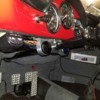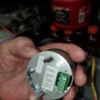.
@dlearl476 posted:....when you’re pulling a grade in fourth and the temp starts to rise, downshifting will bring them back down. Increased R’s increase fan speed and the lower gear gives better mechanical advantage for the engine, requiring less work...
It's this, and a dozen similar things, that makes driving these cars distinctly different from driving modern cars. You will soon find yourself listening to the engine and watching the oil temp gauge as you drive, and noticing what makes the engine heat up and cool down. You'll start to sense when it's working hard and when it's breathing easy. The clues may be subtle, but you'll learn them. And they will change how you drive the car.
Before long, you'll be able to anticipate what the gauge is reading just by observing ambient temp, grade, gear, rpm's and what driving conditions have been in the past few minutes.
I understand the utility of a CHT gauge, especially when you're setting up and tuning a new engine (or one that is new to you). Your mechanic is right to want the feedback that provides. But you might want to rethink making it one of the primary gauges on your dash. As Bruce (aircooled) has discovered, in time, once an engine installation is dialed in, CHT data is less crucial and the oil temp gauge will probably suffice.
You've got a ton of things on your plate now, and instrumentation is probably pretty far down the priority list. In time, you may want to upgrade all of those instruments and rearrange the whole dash, so maybe putting in a CHT gauge under the dash in a separate housing now is a better way to go. You can move it, eliminate it, or replace it with a unit that coordinates better with the rest of your gauges later.
.








